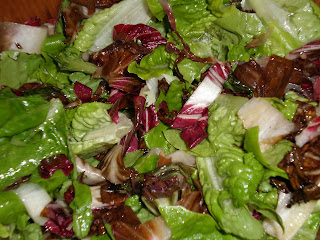


Well, it looks like winter may finally come our way tonight. It's delayed arrival, did, however, give me a chance for some last minute garden additions that just may make it! Here you see what I guess I will call a "winter greens mix." 5 weeks ago, on one of the last days of October, at a time that is usually much too late to do such things, I cleaned out my seed stash of all old lettuce, kales, turnips, and other winter greens packets. I figured they were old, and probably would not germinate well, and, to be honest, I knew I couldn't buy any new stuff next year with all these old packets already in hand! I had an open section of garden where the sweet potatoes had been, so I scattered all the seeds throughout. And look! Everything, and I mean everything, germinated. I thinned it down a few weeks later, and now you see a bed of lovely mixed greens. They are small, but sturdy. I will start harvesting some leaves to add spice and color and texture to salads, and will wait and see what makes it though the winter. A fun use for old seeds and a bare patch.
My next, and even later experiment was the garlic you see here. That didn't make it into the ground until mid November. Any other year it probably would have been a bust, and just rotted in the cold, wet ground. Not this year! I have nice, strong new garlic shoots peeking out. If all goes well, I will harvest my first ever garlic crop late next summer. I kept in mind the long season for growing garlic, and put it on the edge of a bed where it won't interfere with my spring and summer plantings.
Finally, here you see a photo of my first efforts at rappini (also called broccolini). This is the green you buy with cute little heads that look like tiny broccoli, and serrated greens surrounding them. It is a great, bitter green for Italian cooking. Well, I expected a short crop, sort of like arugula. After all, when you buy this it is only about 9 inches long. Surprise! This plant grows tall, over 3 feet, before putting out that tiny, now pitiful looking shoot. Your yield per volume of garden space is small, really small. If I had a large garden I may grow this again, as I love the crop, but it makes no sense for my tiny garden. I can grow other greens that substitute just fine (such as arugula), and get a much higher yield per square foot. The good news? The hens love these plants, and I am now pulling out one each day to feed to them.









